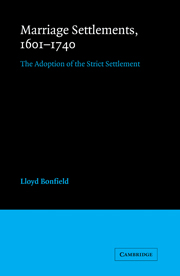Book contents
- Frontmatter
- Contents
- List of tables
- Preface
- List of abbreviations
- Introduction
- 1 The medieval inheritance and the Statute of Uses
- 2 Law in transition: the conflict over restraints upon alienation
- 3 Patterns of marriage settlement 1601–1659: the development of the ‘life estate-entail’ mode
- 4 The emergence of the strict settlement
- 5 The adoption of the strict settlement 1660–1740: Kent and Northamptonshire
- 6 Marriage settlements in perspective: the social and economic aspects
- Conclusion
- Bibliography
- Index
- CAMBRIDGE STUDIES IN ENGLISH LEGAL HISTORY
1 - The medieval inheritance and the Statute of Uses
Published online by Cambridge University Press: 07 October 2011
- Frontmatter
- Contents
- List of tables
- Preface
- List of abbreviations
- Introduction
- 1 The medieval inheritance and the Statute of Uses
- 2 Law in transition: the conflict over restraints upon alienation
- 3 Patterns of marriage settlement 1601–1659: the development of the ‘life estate-entail’ mode
- 4 The emergence of the strict settlement
- 5 The adoption of the strict settlement 1660–1740: Kent and Northamptonshire
- 6 Marriage settlements in perspective: the social and economic aspects
- Conclusion
- Bibliography
- Index
- CAMBRIDGE STUDIES IN ENGLISH LEGAL HISTORY
Summary
The making of financial arrangements at marriage has been a concern of landed families in England since Anglo-Saxon times. In a society with high mortality and one in which men controlled the bulk of wealth-producing property, perhaps the most pressing concern was to secure provision for women who survived their husbands. The Anglo-Saxons provided for their widows through the institution of morgengifu. Early on, the common law recognized the obligation of the groom to endow his wife at the church door, and directed an appropriation of land at his death if he failed to do so. Towards the close of the Middle Ages the provision for maintenance was coupled with the transmission of the patrimony between the generations by marriage settlement. The early modern marriage settlement, the subject of this study, was an elaboration of this medieval form.
The increased incidence of marriage settlements in the fourteenth century can in part be attributed to the popularity of feoffments to uses. Because common law dower attached only to lands of which her husband had stood seised, a widow could not claim her thirds in land held to his use. Legal commentators in the sixteenth century who opposed uses argued that one of their most serious consequences was that they deprived widows of their dower.
- Type
- Chapter
- Information
- Marriage Settlements, 1601–1740The Adoption of the Strict Settlement, pp. 1 - 10Publisher: Cambridge University PressPrint publication year: 1983

